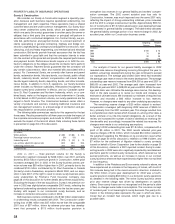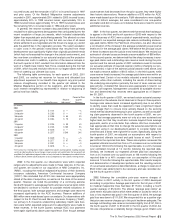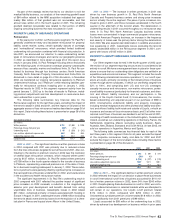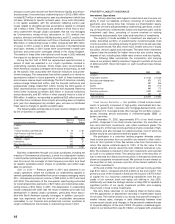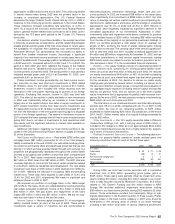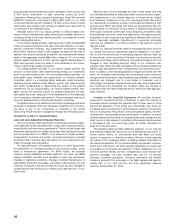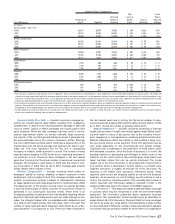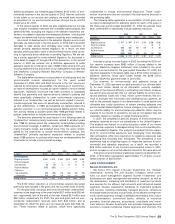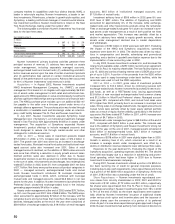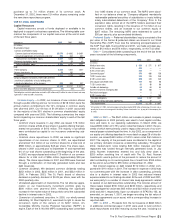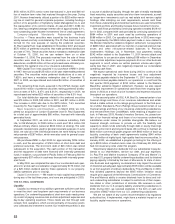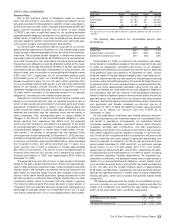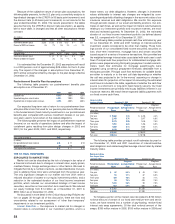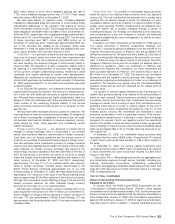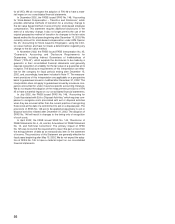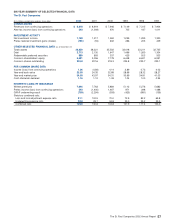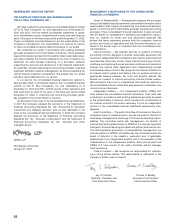Travelers 2002 Annual Report Download - page 50
Download and view the complete annual report
Please find page 50 of the 2002 Travelers annual report below. You can navigate through the pages in the report by either clicking on the pages listed below, or by using the keyword search tool below to find specific information within the annual report.
of claim payment, or for policies that have not been identified as cases
where the underwriter intended coverage. A significant portion of the
cost of administering these claims relates to claims that are eventually
settled without payment. Changes in social, judicial, legislative and
economic conditions could result in future unforeseen developments
and require reserve adjustments.
Asbestos — This exposure relates to general liability and workers’
compensation coverages on policies which can be interpreted to
cover asbestos-related exposures.This portion of business is defined
as that which is reported as “Asbestos losses” as described in more
detail on pages 48 through 49 of this discussion. Amounts are driven
by a few very large claims, accompanied by a large number of very
small claims or claims made with no payment. A significant portion of
the cost of administering the claims is spent on those claims that are
eventually settled without payment. Social, judicial, legislative and
economic changes could result in future unforeseen developments
and require reserve adjustments. Western MacArthur accounted for
the majority of paid losses on settled claims in 2002 ($173 million), as
well as the majority of costs to administer in 2002 ($12 million), with
the remainder relating to claims made in prior years. Approximately
25% of the pending asbestos claim supplements as of December 31,
2002 came from policyholders who tendered their first asbestos claim
within the last three years.The increase in newly reported claims arise
from policyholders who tendered their first claim to us within the last
three years. For example, approximately 59% of the claim supple-
ments reported during 2002 came from policyholders who tendered
their first claim after January 1, 2000. These claims are generally rel-
atively small and have, to date, presented minimal exposure.
Assumed Reinsurance — This portion of our business represents
our reported Reinsurance segment and includes property and liability
loss exposures assumed on both a proportional and excess of loss
basis. There are both low frequency, high severity exposures as well
as some event-driven high-severity exposures. A significant portion of
the high exposure business was catastrophe related. As of Novem-
ber 2, 2002, we are no longer significantly exposed to subsequent
events due to the transfer of our ongoing reinsurance operations to
Platinum Underwriters Holdings, Ltd. Although our property exposure
(included in this data) is not considered long tail, our casualty expo-
sure is considered long tail and — similar to our primary general lia-
bility exposures — is sensitive to the risk of unexpected increases in
inflation. The increase in loss settlement amounts during 2001 and
2002 was primarily due to losses resulting from the September 11,
2001 terrorist attack.
Prior-Year Loss Development Note 11 to the consolidated
financial statements includes a reconciliation of our beginning and
ending loss and loss adjustment expense reserves for each of the
years 2002, 2001 and 2000. That reconciliation shows that we
recorded an increase in the loss provision from continuing operations
for claims incurred in prior years totaling $1.0 billion in 2002, com-
pared with $577 million in 2001, and a reduction in prior-year incurred
losses of $265 million in 2000. Of the 2002 total, $472 million resulted
from the settlement of the Western MacArthur asbestos litigation, as
described in more detail on pages 27 through 28 of this discussion.
The majority of the remaining prior year development was concen-
trated in our Health Care, Surety & Construction, and Other seg-
ments, and that development is discussed in detail in the respective
segment sections included herein.
The increase in prior-year loss provisions in 2001 was driven by
additional losses in our Health Care segment. In 2000, loss trends in
this segment had indicated an increase in the severity of claims
incurred in the 1995 through 1997 accident years; accordingly, we
recorded a provision for prior-year losses. In 2001, loss activity con-
tinued to increase not only for the years 1995 through 1997, but also
1998, and early activity on claims incurred in the years 1999 through
2001 indicated an increase in severity for those years.Those develop-
ments led us to a much different view of loss development in this seg-
ment, which in turn caused us to record provisions for prior-year
losses totaling $735 million in this segment in 2001. At the end of the
48
year, we announced our intention to withdraw fully from the medical
liability insurance market.
A reduction in prior-year losses was recorded in 2000.In 2000, the
favorable prior-year loss development was widespread across our
business segments, with the exception of the Health Care segment.
The following table summarizes the composition of our gross and
net loss and loss adjustment expense reserves by segment as of
December 31, 2002.
December 31, 2002 Gross Net
(In millions)
Specialty Commercial $3,694 $ 2,065
Commercial Lines 5,870 4,062
Surety & Construction 2,055 1,386
International & Lloyd’s 2,152 1,080
Subtotal – ongoing segments 13,771 8,593
Health Care 2,521 1,981
Reinsurance 4,337 3,019
Other 1,997 1,256
Subtotal – runoff segments 8,855 6,256
Total $22,626 $ 14,849
PROPERTY-LIABILITY UNDERWRITING
Environmental and Asbestos Claims
We continue to receive claims, including through lawsuits, alleging
injury or damage from environmental pollution or seeking payment for
the cost to clean up polluted sites. We also receive asbestos injury
claims, including through lawsuits, arising out of coverages under
general liability policies. Most of these claims arise from policies writ-
ten many years ago. Significant legal issues, primarily pertaining to
the scope of coverage, complicate the determination of our alleged
liability for both environmental and asbestos claims. In our opinion,
court decisions in certain jurisdictions have tended to broaden insur-
ance coverage for both environmental and asbestos matters beyond
the intent of the original insurance policies.
Our ultimate liability for environmental claims is difficult to estimate
because of these legal issues. Insured parties have submitted claims
for losses that in our view are not covered in their respective insur-
ance policies, and the final resolution of these claims may be subject
to lengthy litigation, making it difficult to estimate our potential liability.
In addition, variables such as the length of time necessary to clean up
a polluted site, and controversies surrounding the identity of the
responsible party and the degree of remediation deemed necessary,
make it difficult to estimate the total cost of an environmental claim.
Estimating our ultimate liability for asbestos claims is also very dif-
ficult. The primary factors influencing our estimate of the total cost of
these claims are case law and a history of prior claim development,
both of which continue to evolve and are complicated by aggressive lit-
igation against insurers, including us. Estimating ultimate liability is
also complicated by the difficulty of assessing what rights, if any, we
may have to seek contribution from other insurers of any policyholder.
Late in 2001, we hired a new Executive Vice President of Claims,
with extensive experience with environmental and asbestos claims
handling and environmental and asbestos reserves, who conducted a
summary level review of our environmental and asbestos reserves.As
a result of observations made in this review, we undertook more
detailed actuarial and claims analyses of environmental reserves. No
adjustment to reserves was made in the fourth quarter of 2001, since
management did not have a sufficient basis for making an adjustment
until such supplemental analyses were completed, and we believed
our environmental and asbestos reserves were adequate as of
December 31, 2001.
Our historical methodology (through the first quarter of 2002) for
reviewing the adequacy of environmental and asbestos reserves uti-
lized a survival ratio method, which considers ending reserves in rela-
tion to calendar year paid losses. When the environmental reserve
analyses were completed in the second quarter of 2002, we supple-
mented our survival ratio analysis with the detailed additional
analyses referred to above, and concluded that our environmental
reserves were redundant by approximately $150 million.Based on our


